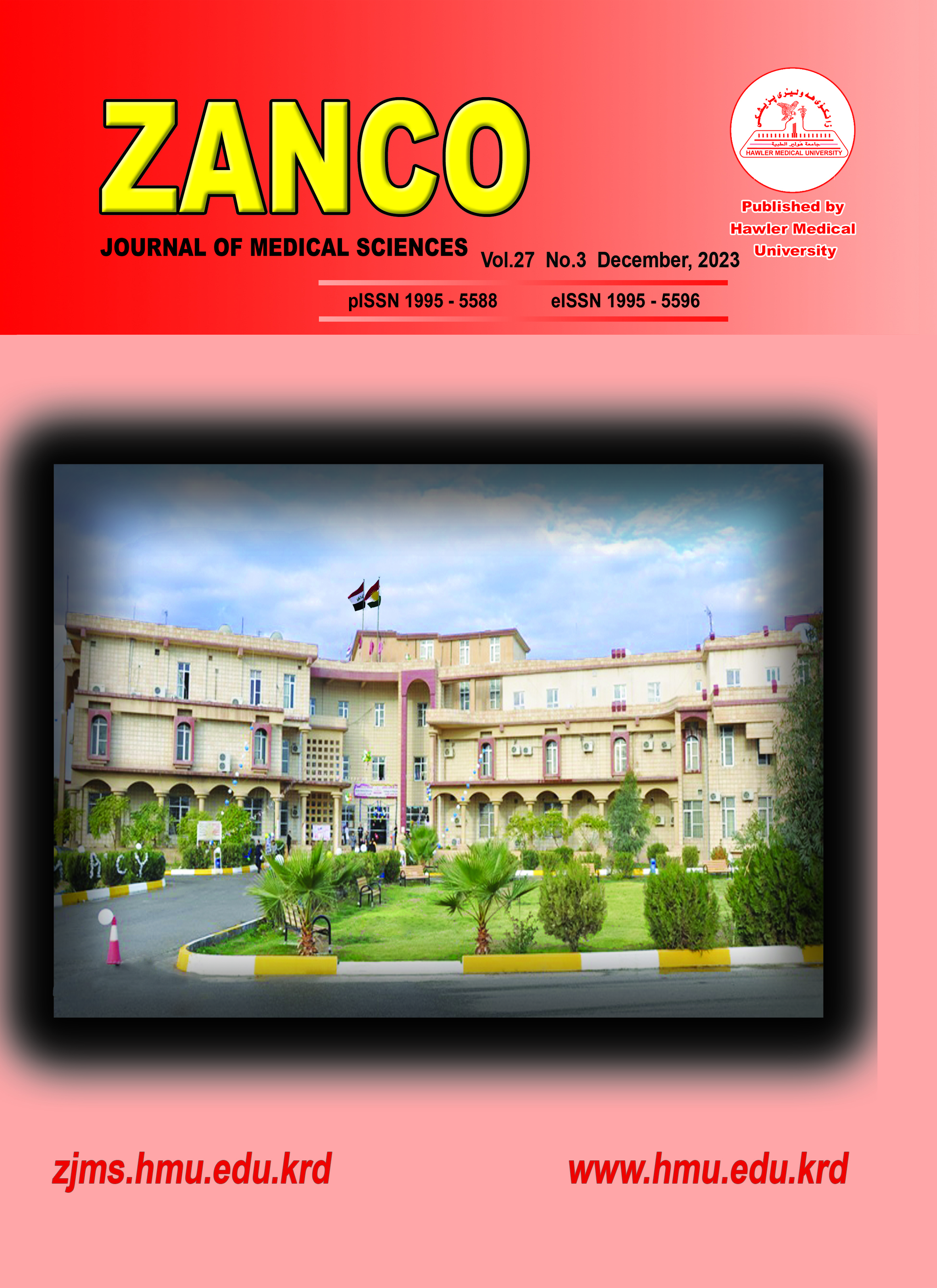Copyright (c) 2023 Azhy Muhammed Dewana, Baderkhan Saeed Ahmed, Ahmed Abdulkadir Baban, Rawand Musheer Haweizy (Author)

This work is licensed under a Creative Commons Attribution-NonCommercial-ShareAlike 4.0 International License.
- Articles
- Submited: June 16, 2022
-
Published: December 20, 2023
Abstract
Background and objective: Chronic anal fissure is a common health problem related to high morbidity. The chemical option for treating chronic anal fissures is highly preferred.
Methods: A clinical prospective comparative study was carried out in the General Surgery Outpatient Department in Rizgary Teaching Hospital, Erbil, KRG, during the period from January 2019 to December 2021,on a sample of 100 patients randomly recruited patients with chronic anal fissures divided into two groups with 50 participants each: the DTZ group, who received 2% diltiazem ointment, and the GTN group, who used 0.2% glyceryl trinitrate ointment twice daily for 6 consecutive weeks. The aim of the study is to compare the efficacy and effects of topical Diltiazem (DTZ) and topical glyceryl trinitrate (GTN) in the management of chronic anal fissures.
Results: There was a highly significant association between fissure healing at the 4th week and patients treated with DTZ (P <0.001). A highly significant association was observed at the 6th week between fissure healing and DTZ treatment (P <0.001), while there was later a highly significant association between fissure healing at the 8th week and patients treated with GTN (P <0.001). A significant association was observed between treatment adverse effects and patients treated with GTN (P = 0.05). DTZ was found to be more effective for symptomatic relief than GTN.
Conclusion: Both DTZ and GTN are effective in the treatment of chronic anal fissures, but treatment with DTZ is accompanied by faster healing and lower side effects.
Metrics
References
- Poh A, Tan KY, Seow-Choen F. Innovations in chronic anal fissure treatment: A systematic review. World J Gastrointest Surg 2010; 2(7):231‒41. DOI: 10.4240/wjgs. v2. i7.231
- Jonas M, Speake W, Scholefield JH. Diltiazem heals glyceryl trinitrate-resistant chronic anal fissures: a prospective study. Dis Colon Rectum 2002; 45(8):1091‒5. DOI: 10.1007/s10350-004-6365-z
- Ehrenpreis ED, Rubin DT, Ginsburg PM. Treatment of anal fissure with topical nitroglycerin. Expert Opin Pharmacother 2010; 2:41‒5. DOI: 10.1517/14656566.2.1.41
- Zuberi BF, Rajput MR, Abro H, Shaikh SA. A randomised trial of glyceryl trinitrate ointment and nitroglycerin patch in the healing of anal fissures. Int J Colorectal Dis 2000; 15:243‒5. DOI: 10.1007/s003840000230
- Haq Z, Rahman M, Chowdhury RA, Baten MA, Khatun M. Chemical sphincterotomy –the first line of treatment for chronic anal fissure. Mymensingh Med J 2005; 14:88‒90. PMID: 15695964
- Yousuf M, Hussain M, Humaira JY. Topical application of Glyceryl trinitrate 0.2% for Fissure-in-ANO. J Surg Pak 2003; 8:22‒4. DOI: 10.2009/JCPSP.614617
- Acheson AG, Scholefield JH. Anal fissure: the changing management of a surgical condition. Langenbecks. Arch Surg 2005; 390:1–7. DOI: 10.1007/s00423-003-0430-2
- Knight JS, Birks M, Farouk R. Topical diltiazem ointment in the treatment of chronic anal fissure. Br J Surg 2001; 88(4):553‒6. DOI: 10.1046/j.1365-2168.2001. 01736.x
- Utzig MJ, Kroesen AJ, Buhr HJ. Concepts in pathogenesis and treatment of chronic anal fissure. A review of the literature. The American Journal of Gastroenterology 2003; 98:968–74. DOI: 10.1111/j.1572-0241.2003. 07423.x
- Hyman NH, Cataldo PA. Nitroglycerin ointment for anal fissures: effective treatment or just a headache? Dis Colon Rectum 1999; 42:383‒5. DOI: 10.1007/BF02236358
- Shrivastava UK, Jain BK, Kumar P, Saifee Y. A comparison of the effects of diltiazem and glyceryl trinitrate ointment in the treatment of chronic anal fissure: a randomized clinical trial. Surg Today. 2007; 37:482‒5. DOI: 10.1007/s00595-006-3431-2
- Lindsey I, Jones OM, Cunningham C, Mortensen NJ. Chronic anal fissure. Br J Surg 2004; 91:270‒9. DOI: 10.1002/bjs.4531
- Venkatesh S, Kulkarni SB, Kruthi SR. Topical diltiazem versus topical glyceryl trinitrate in the treatment of chronic anal fissure: a prospective comparative study. Int Surg J 2019; 6:1127‒30. DOI: http://dx.doi.org/10.18203/2349-2902.isj20191088
- Tsunoda A, Kashiwagura Y, Hirose K, Sasaki T, Kano N. Quality of life in patients with chronic anal fissure after topical treatment with diltiazem. World J Gastrointest Surg 2012; 4(11):251‒5. DOI: 10.4240/wjgs. v4. i11.251
- Zghair LF. Diltiazem Gel 2% in the treatment of acute fissure in ANO. The Pharma Innovation Journal 2016; 5(11):22‒5.
- Suvarna R, Hanumanthappa MB, Panchami, Rai G. Topical Diltiazem versus topical Glyceryl trinitrate (GTN) in the treatment of chronic anal fissure: Prospective study. Int J Biol Med Res 2012; 3(2):1747‒50.
- El Tinay OEF, Guraya SY. The use of 0.2% glyceryl trinitrate ointment for anal fissures. Saudi J Gastroenterol 2005; 11:40‒4. DOI: 10.4103/1319-3767.33336
- Palazzo FF, Kapur S, Steward M, Cullen PT. Glyceryl trinitrate treatment of chronic fissure in ano: one year's experience with 0.5% GTN paste. J R Coll Surg Edinb 2000; 45(3):168‒70. PMID: 10881483
- Altomare DF, Rinaldi M, Milito G. Glyceryltrinitrate for chronic anal fissure--healing or headache? Results of a multicenter, randomized, placebo-controlled, double-blind trial. Dis Colon Rectum 2000; 43(2):174‒81. DOI: 10.1007/BF02236977
- Medhi B, Rao RS, Prakash A, Prakash O, Kaman L, Pandhi P. Recent advances in the pharmacotherapy of chronic anal fissure: an update. Asian J Surg 2008; 31(3):154‒63. DOI: 10.1016/S1015-9584(08)60078-0
- Hashmi F, Siddiqui FG. Diltiazem (2%) versus glyceryl trinitrate cream (0.2%) in the management of chronic anal fissure. J Coll Physicians Surg Pak 2009; 19(12):750‒3. PMID: 20042150
- Tauro LF, Shindhe VV, Aithala PS, Martis JJ, Shenoy HD. Comparative Study of Glyceryltrinitrate Ointment Versus Surgical Management of Chronic Anal Fissure. Indian J Surg 2011; 73:268–77. DOI: 10.1007/s12262-011-0239-0





